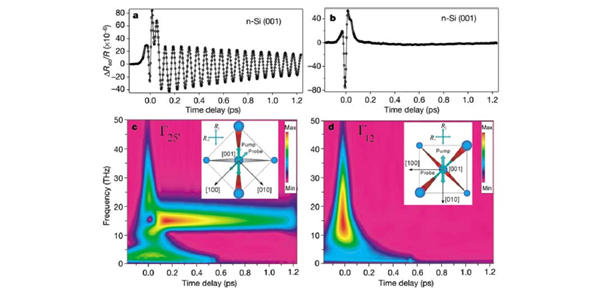Coherent phonon
When a crystal is irradiated with a laser having an extremely short pulse width, shorter than a phonon period, phonons are generated with a same phase all at once. This excites coherent phonons - in contrast to thermal excitation which excites many phonon modes.
Coherence phonon has been reported from materials with nanostructures such as carbon nanotubes. While it has been known since the 1980s, coherent phonons are still the subject of much debate. Verification from both theory and experiment is therefore essential.
RUEDI captures not only the temporal resolution of tracking coherent phonons, but also the changes in spatial distribution at nanometer resolution. It uses an electron beam with high penetrability and is equipped with both electron diffraction and electron microscopy. In addition to very thin films, micron-thick samples that reflect bulk properties can be studied in reciprocal lattice space and real space.
Reference: The birth of a quasiparticle in silicon observed in time–frequency space, Muneaki Hase, Masahiro Kitajima, Anca Monia Constantinescu & Hrvoje Petek, NATURE |VOL 426 | 6 NOVEMBER 2003 | www.nature.com/nature.

Figure 1: Transient electro-optic reflectivity signals for Si(001), and their continuous wavelet transforms. a, b, Transient electro-optic reflectivity signal for Si(001) in 2s (a) and I12 (b) geometry. c, d, Continuous wavelet transforms (CWT chronograms) of the data in a and b, respectively. Left insets in c and d define the polarization of the laser beams relative to the crystalline axes of the sample in the Is and I geometries. Blue spheres indicate Si atoms in the diamond lattice with size denoting upward or downward disposition with respect to the central atom. Excited or quiescent bonds are represented by red and grey. The signal in a and b is derived from the difference in R and R, the orthogonal polarization components of the probe beam. The colour scale indicates the signal amplitude, red being the maximum. Three-dimensional CWT animations can be viewed at http://www.phyast.pitt.edu/People/Faculty/H_Petek/30wavelet.